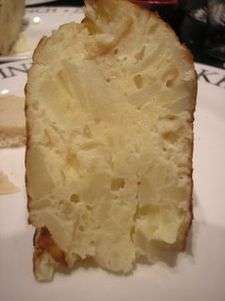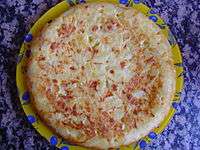Spanish omelette
|
Spanish omelette cut in half. | |
| Alternative names |
Spanish tortilla tortilla de patatas |
|---|---|
| Course | Appetizer or main course |
| Serving temperature | Hot or cold |
| Main ingredients | Egg and potatoes. |
| Variations | With onions, addition of green or red peppers, etc. |
|
| |
Spanish omelette[1] is the English name for a traditional dish from Spanish cuisine called tortilla española or tortilla de patatas. It is an omelette made with eggs and potatoes, sometimes also with onion and/or chives or garlic; fried in oil and often served cold as an appetizer. It is part of the cuisine of Spain and many South American countries, especially Argentina.
Spanish names
In Spanish, this dish is called tortilla de patatas or tortilla española to distinguish it from a plain omelette (tortilla francesa, literally "French omelette"). Tortilla in origin meant just "small torte/cake". These dishes are unrelated to the maize or wheat tortilla of Mexico and neighbouring countries, which is a thin flatbread. In northern South America, where both the Mexican and the Spanish tortilla are found, the appellation "tortilla española" distinguishes it from the maize tortilla original to nearby Mesoamerica.
Preparation

The Spanish tortilla (tortilla de patatas in Spain) is widely eaten in Spain and some Spanish-speaking countries. While there are numerous regional variations, the basic version is made only with eggs and potatoes, and possibly onion. The addition of the onion is often controversial and usually related to the tenderness of the local varieties of potatoes. To avoid confusions some restaurants distinguish between the plain tortilla de patatas and the tortilla de patatas con cebolla (with onion).
The potatoes, ideally a starchy variety, are cut into thin slices or small dice. They are then seasoned and stewed in abundant oil (which can be kept and re-used), sliced onions being added at this stage if used, stirring, at a moderate temperature until they are soft but not brown. The potatoes are then removed, drained, and mixed with beaten eggs. This mixture is then returned to the pan and slowly fried, turning to fry both sides.[1][2] The essential ingredients are eggs, potatoes, and salt; onion or garlic is very often added; seasonings such as pepper, parsley or oregano may be added. Other ingredients such as green or red peppers, chorizo or other sausage, tuna, shrimp or different vegetables, may also be added, although the result is not strictly a tortilla de patatas/papas. The Spanish government food Web site specifies extra virgin olive oil and includes onion,[3] but some recipes simply state vegetable oil.
The tortilla may be eaten hot or cold; it is commonly served as a tapa or picnic dish throughout Spain. As a tapa, it may be cut into bite-size pieces and served on cocktail sticks; a large tortilla can be cut into triangular portions (pincho de tortilla).
History

The first reference to the tortilla in Spanish is found in a Navarrese document. It is an anonymous "Mousehole's memorial" addressed to Navarra's Court in 1817. It explains the sparse conditions of the farmers in contrast with Pamplona's and the Ribera's inhabitants. After listing the sparse food eaten by highlanders, the next quote follows: "…two to three eggs in tortilla for 5 or 6 [people] as our women do know how to make it big and thick with less eggs, mixing potatoes, breadcrumbs or whatever."[4]
According to legend, during the siege of Bilbao, Carlist general Tomás de Zumalacárregui created the "tortilla de patatas" as an easy, fast and nutritious dish to satisfy the scarcities of the Carlist army. Although it remains unknown whether this is true, it appears the tortilla started to spread during the early Carlist wars.
Another tale is that during the war, Zumalacárregui was in the field and happened upon a farmhouse and demanded a meal from the farmwife. All she had were a few eggs, a potato and an onion, so she combined all three, making an omelette. Surprisingly, Zumalacárregui was pleased and took the idea with him.
Variations
Spanish omelettes can range from authentic and carefully made seasoned preparations of raw potatoes of a variety carefully selected for best results, eggs, optional onions and good olive oil and nothing else, to nontraditional preparations with many additional ingredients.
Some of the many additions to the base ingredients include green peppers, chorizo, courgette, aubergine, mushrooms, and diced ham. The tortilla paisana includes red pepper and peas. The tortilla is supposed to be juicy and usually fairly thick, ranging from about 3 to 8 cm (1.2 to 3.1 in);[5] circumference ranges from a small individual tortilla to about 30 cm (12 in). In Spain a tortilla is almost always accompanied by bread and sometimes with fried pimientos de padron. In most bars and canteens, it is served in a sandwich (bocadillo). A tortilla will remain juicy for around 24 hours, after this it will solidify (see picture to the right).
A very large tortilla was made by 12 chefs in Vitoria, Spain in 2014, claiming to be a record. It was 5 m (16 ft) in diameter, and used 1.6 tons of potatoes, 16,000 eggs, 150 l (33 imp gal; 40 US gal) of oil, 26 kg (57 lb) of onions, and 15 kg (33 lb) of salt.
- Asturian tortiella de pataques, characterised by its thickness.
 Tortilla de patatas with a less-fried finish
Tortilla de patatas with a less-fried finish
See also
| Wikibooks Cookbook has a recipe/module on |
References
- 1 2 "Real Spanish omelette". Bbcgoodfood.com. Retrieved 10 January 2016.
- ↑ "Trucos para Preparar una Deliciosa Tortilla de Patata" [Tricks for making a delicious potato tortilla]. Palacios.es (in Spanish). Retrieved 10 January 2016. A typical recipe
- ↑ "Tortilla de patatas / Conoce lo que comes / Enciclopedia de los Alimentos / Patata / Recetas". Spanish Government Ministry of Agriculture, Food, and Environment. Retrieved 23 January 2016. (Spanish)
- ↑ (Spanish) Los "memoriales de ratonera" eran escritos que cualquier ciudadano navarro podía depositar en un buzón ("ratonera") cuando se reunían las Cortes; véase José María Iribarren: "El comer, el vestir y la vida de los navarros de 1817, a través de un 'memorial de ratonera'", en: Príncipe de Viana 17, núm. 65 (1956), pp. 473-486.
- ↑ "tortilla de patata". Cocina.facilisimo.com (in Spanish). Retrieved 10 January 2016. 8cm high tortilla
| Wikimedia Commons has media related to Spanish omelette. |
